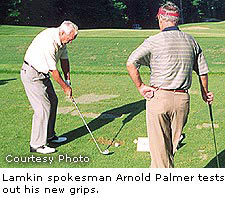Coming to Grips: Q & A with Bob Lamkin

Bob Lamkin runs the family business, just like his father and his father’s father did. Lamkin’s grandfather, Elver, started Lamkin Grips in Chicago in 1925. The company was founded on the eldest Lamkin’s innovation of a leather wrap-on grip, impregnated with a “tactifying” compound to make it tackier and give golfers better control over the club. Lamkin’s father, Robert, moved the company to sunny San Diego in 1985 and continued the tradition of innovation in grip materials.
Bob Lamkin, 48, is the third generation in the gripping Lamkin family saga. He took over as president and CEO of the company in 1997. Today, Lamkin Grips is the oldest grip manufacturer in the world, and the second-largest behind Golf Pride, with over $20 million in annual sales.
Lamkin sat down with GolfInstruction.com for a chat about his gripes with grips, his company’s association with Arnold Palmer, and the company’s commitment to fighting prostate cancer.
GI: Why should the average golfer worry about his or her grips?
Lamkin: What really needs to be impressed on your readers is the importance of re-gripping and sizing. [Modern] grips last longer than they used to, but the more you practice and play, the more you should re-grip, because when the grip starts to wear, your hold on the club tightens, and this restricts your swing.
GI: What about sizing?
Lamkin: One size does not fit all. When you get fitted for clubs, or go in to re-grip, get fitted for grips, too. People notice a big difference just by changing grip sizes. If the grip is too large, your hands stay open. If they’re too small, the hands close too soon. We even make oversized yet light grips, which are wider but lighter for shorter people with bigger hands. The grip is totally overlooked. If people pay attention to their grips, they will play better golf.
GI: What’s the next big thing in grips?
Lamkin: 
The next generation [of advances] will continue to be in materials. We’re working on a number of products outside of the standard materials used today. These materials make grips lightweight, more durable, and are different colors. These are things we couldn’t do not too long ago.
GI: What’s changed most dramatically since your grandfather’s days, and in your tenure at the helm?
Lamkin: Again, the materials. In the 1960s to 1980s, [the main ingredient] was natural rubber. They felt good when they were first put on, but didn’t last long when exposed to the elements. We now have a new synthetic base that allows grips to last for up to three years, and are more consistent in different types of weather. We use 12 to 15 different formulas that we work with different manufacturers to create to match with their club specifications.
GI: So the Lamkin grip on one company’s driver is not the same as the Lamkin grip on another driver, even if it looks the same.[Lamkin produces custom grips for several major manufactuers, including Nike and TaylorMade.]
Lamkin: Right. They’re matched to the weighting scheme of each manufacturer’s clubs.
GI: 
How long has Arnold Palmer been Lamkin spokesman?
Lamkin: Since 1995. He personifies what we’re all about.
GI: Have you played golf with him?
Lamkin: I have golfed with him several times. It’s like playing with one of your buddies. He’s a true gentleman.
GI: Lamkin has made a commitment to prostate cancer research. How did that come about?
Lamkin: We have always participated in charitable contributions and events. But we couldn’t be all things to all people. In 2001, I lost my brother-in-law suddenly to [a different type of] cancer. This sent a shockwave through the family. It seemed like a natural fit to support prostate cancer, since Mr. Palmer is a survivor himself.
GI: What is the extent of the commitment?
Lamkin: We’re donating a percentage of total annual sales – about 5 percent. It was going to be a private donation, but we decided to make it public because of the profile of Mr. Palmer. It does certainly serve as PR for us, but that’s not the main reason for going public with the program. We are hoping that his name will help us to raise more funds for research.
GI: What’s your handicap, and what’s your career low score?
Lamkin: My handicap is currently 3. My lowest round was a 68 at my home course, San Diego Country Club.
GI: What’s in your bag?
Lamkin : My biggest problem is that I change clubs too often, because I get it all provided by manufacturers. Let’s just say that I am fortunate to have grown up with the best technology in the history of the game. I’d like to see more people get fitted—not just for grips—but for everything, in order to take advantage of the technology. Especially drivers and woods. The right combination of loft and shaft will help you hit it farther and straighter. I can tell you that my grips are all Lamkin, though.
November 28, 2005
Kiel Christianson has lived, worked, traveled and golfed extensively on three continents. As senior writer and equipment editor for WorldGolf.com, he has reviewed courses, resorts, and golf academies from California to Ireland, including his home course, Lake of the Woods G.C. in Mahomet, Ill. Read his golf blog here and follow him on Twitter @GolfWriterKiel.
